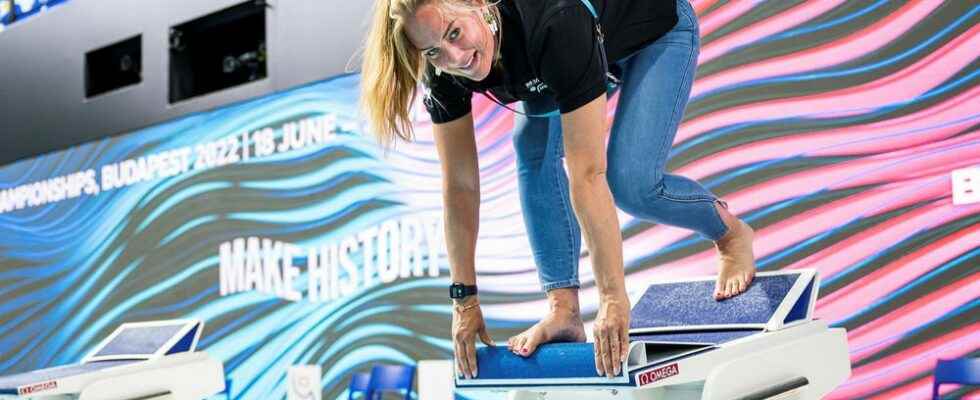Ida Marko-Varga looks out over the World Cup pool in Duna arena in Budapest.
– When I saw 200 meters of butterfly swim, I got the urge to participate, says the 37-year-old.
Given that 200 meters of butterfly swimming hurts the whole body, the longing may seem a little strange.
– I think it’s because I feel that I never got the best out of 200 meters butterfly swimming, she says.
Ida Marko-Varga’s swimming career was otherwise long and successful. She participated in four Olympics, and has won medals in both the Short Course World Championships and the Short Course Championships.
Now that part of her life is over.
Although she had plans to try to get to the Olympics in Tokyo – and touch Therese Alshammar’s record of five Olympics – but then came the pandemic.
Instead of the Olympics, it was a move to Thailand.
Autumn 2020 Ida, her husband Sebastian and the couple’s two children left Malmö to start their new life at Rugby School Thailand, just over an hour from Bangkok.
The Marko-Varga couple were employed to build up the school’s swimming program, start a swimming club and attract national teams to training camps.
When the pandemic continued to hold the world in a firm grip, nothing turned out as intended.
– Most of our plans could not be implemented and sometimes it felt lonely even if we made friends, says Ida Marko-Varga.
– But I do not regret that we tested. The children enjoyed themselves very much and it was an exciting experience.
Now the Marko-Varga family is back in Skåne, but somewhat unexpectedly, the move home was also a change.
Back in everyday life, it became clear to Ida that she was no longer an elite athlete. The question was who she was then.
– Sebbe has been calm all the time, but sometimes I have not felt so good. For three or four months I was even really down, and thought a lot about what I should do, says Ida Marko-Varga.
– But now that good things have started to happen, the joy is back.
In Budapest The World Swimming Championships are underway and Ida and her husband Sebastian are on site in the Hungarian capital to show the starting podium they are working on, and which they hope will be approved by Fina, the international swimming federation.
The story of how the starting podium came to be begins in the United States.
– My cousins - who I would say are swimming nerds – now live in Florida, says Sebastian Marko-Varga.
– There they have helped at the Florida Gators (university teams where Ryan Lochte and Caeleb Dressel, among others, swam) and since they have a master’s degree in mechanical engineering, they have considered whether it is not possible to improve the starting podiums.
When the cousins’ idea began to become more concrete, they contacted Sebastian and Ida, and when a Swedish company was interested, the development took off.
– We have been doing this for a year and a half. It is very exciting and fun, says Ida.
But also patient.
In swimming history there have only been three starting pallets that have been approved by Fina. Now the couple hopes that this will be the fourth, but nothing is solved in a jiffy.
– The most important thing for us is that we have received very good feedback from swimmers and coaches. Then it is clear that we lobby for it to be approved, it follows all of Fina’s rules, and we are happy with every step forward we take, says Ida Marko-Varga.
The biggest difference compared to the starting stool used during the WC is that the starting stool that the Marko-Varga couple works with is rounded at the front.
– Thanks to that, you get the entire forefoot around the edge, and not just the toes. This means that you get a much better pressure from the podium, and therefore a much longer jump, Ida Marko-Varga explains.
– It is also flatter – while today’s stools are sloping downwards – which also contributes to the jump being longer. It also makes it easier for swimmers to keep their balance.
The starting podium is not the only one which has made Ida Marko-Varga feel desire and joy again. She has recently completed an education in sports nutrition, and the combination with her previous education as a mental trainer she thinks can be a good mix.
In addition, it is clear that both she and Sebastian will start working in KSLS – Kristianstads Sim- & Livräddningssällskap.
– I want to stay in swimming, and now I have several different things going on that are connected to the sport I love, says Ida Marko-Varga.
– The road here has been a bit crooked. Even if you know that the active career ends one day, you have no idea what will happen to you when that day comes. As an elite athlete, you are used to routines, and when they are shaken, it can be difficult to know how to handle it.
– Of course, it is good to prepare for what awaits you after your career, but the great work of finding a new place in life, I think, does not begin until the day you leave elite sports for good.
Read more:
“Slangbellan” will give Sjöström a flying World Cup start
“Swims the worst when the fat percentage is too low”
